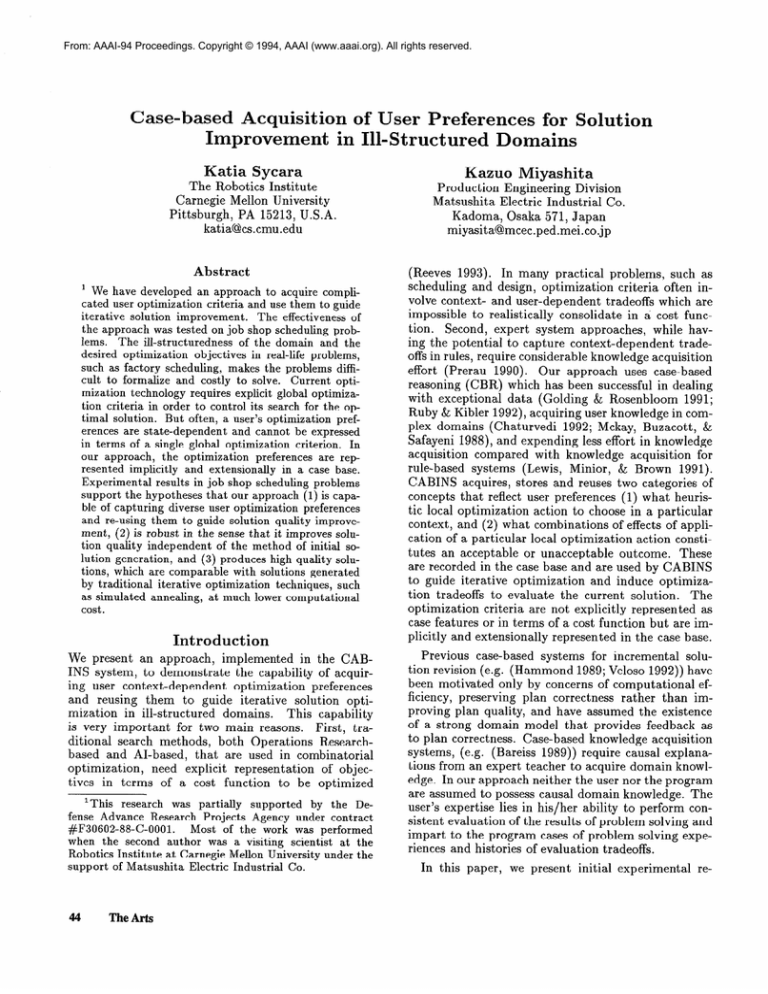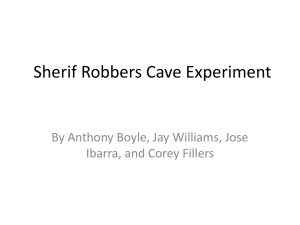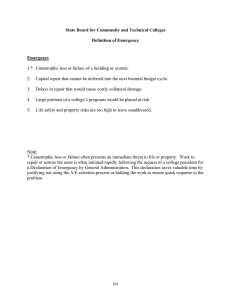
From: AAAI-94 Proceedings. Copyright © 1994, AAAI (www.aaai.org). All rights reserved.
Case-based
Acquisition
of User Preferences for Solution
Improvement
in Ill-Structured
Domains
Katia
Sycara
Kazuo
The Robotics Institute
Carnegie Mellon University
Pittsburgh,
PA 15213, U.S.A.
katia@cs.cmu.edu
Abstract
1 We have developed an approach to acquire complicated user optimization
criteria and use them to guide
iterative
solution improvement.
The effectiveness
of
the approach was tested on job shop scheduling problems.
The ill-structuredness
of the domain and the
desired optimization
objectives
in real-life problems,
such as factory scheduling,
makes the problems difficult to formalize
and costly to solve.
Current optimization technology
requires explicit global optimization criteria in order to control its search for the optimal solution.
But often, a user’s optimization
preferences are state-dependent
and cannot be expressed
in terms of a single global optimization
criterion.
In
our approach,
the optimization
preferences
are represented implicitly
and extensionally
in a case base.
Experimental
results in job shop scheduling problems
support the hypotheses
that our approach (1)is capable of capturing
diverse user optimization
preferences
and re-using them to guide solution quality improvement, (2) is robust in the sense that it improves solution quality independent
of the method of initial solution generation,
and (3) produces high quality solutions, which are comparable
with solutions generated
by traditional
iterative optimization
techniques,
such
as simulated annealing,
at much lower computational
cost.
Introduction
We present an approach,
implemented
in the CABINS system, to demonstrate
the capability of acquiring user context-dependent
optimization
preferences
and reusing them to guide iterative
solution optimization
in ill-structured
domains.
This capability
is very important
for two main reasons.
First, traditional search methods,
both Operations
Researchbased and AI-based,
that are used in combinatorial
optimization,
need explicit
representation
of objectives in terms of a cost function
to be optimized
‘This
research
was
fense Advance
Research
partially
supported
by the DeProjects
Agency under contract
#F30602-88-C-0001.Most of the work was performed
when the second author
was a visiting scientist
at the
Robotics Institute at Carnegie Mellon University under the
support of Matsushita
Electric Industrial
Co.
44
The Arts
Miyashita
Production
Engineering
Division
Matsushita
Electric Industrial Co.
Kadoma, Osaka 571, Japan
miyasita@mcec.ped.mei.co.jp
(Reeves 1993).
In many practical problems,
such as
scheduling and design, optimization
criteria often involve context- and user-dependent
tradeoffs which are
impossible to realistically
consolidate
in a cost function.
Second, expert system approaches,
while having the potential to capture context-dependent
tradeoffs in rules, require considerable knowledge acquisition
effort (Prerau
1990).
Our approach uses case-based
reasoning (CBR) which has been successful in dealing
with exceptional
data (Golding & Rosenbloom
1991;
Ruby & Kibler 1992), acquiring user knowledge in complex domains (Chaturvedi
1992; Mckay, Buzacott,
&
Safayeni 1988)) and expending less effort in knowledge
acquisition
compared
with
knowledge
acquisition
for
rule-based
systems (Lewis, Minior, & Brown 1991).
CABINS
acquires, stores and reuses two categories of
concepts that reflect user preferences (1) what heuristic local optimization
action to choose in a particular
context,
and (2) what combinations
of effects of application of a particular local optimization
action constitutes an acceptable
or unacceptable
outcome.
These
are recorded in the case base and are used by CABINS
to guide iterative optimization
and induce optimization tradeoffs to evaluate the current solution.
The
optimization
criteria are not explicitly represented
as
case features or in terms of a cost function but are implicitly and extensionally
represented in the case base.
Previous case-based
systems for incremental
solution revision (e.g. (Hammond 1989; Veloso 1992)) have
been
motivated
ficiency,
proving
only
preserving
plan
by concerns
of computational
plan correctness
quality,
and
have
rather
assumed
the
ef-
than
im-
existence
of a strong domain model that provides feedback as
to plan correctness.
Case-based knowledge acquisition
systems, (e.g. (Bareiss 1989)) require causal explanations
from
an expert
teacher
to acquire
domain
knowl-
edge. In our approach neither the user nor the program
are assumed to possess causal domain knowledge. The
user’s expertise lies in his/her ability to perform consistent evaluation of the results of problem solving and
impart to the program cases of problem solving experiences and histories of evaluation tradeoffs.
In this
paper,
we present
initial
experimental
re-
sults to test three hypotheses.
First, our CBR-based
incremental
revision methodology
shows good potential for capturing user optimization
preferences in illstructured
domains, such as job shop scheduling, and
re-using them to guide optimization.
Second,
the
method is robust in the sense that it improves solution quality independent
of the method of initial
solution generation.
Third,
CABINS
produces high
quality solutions.
To test this, we compared the solutions produced by CABINS
with explicit optimization criteria, with solutions produced by simulated annealing (a well known iterative optimization
technique
(Johnson
et al. 1991; Zweben, Deale, & Gargan 1990;
Laarhoven, Aarts, & Lenstra 1992)) for the same criteria. Our investigation
was conducted in the domain of
job shop schedule optimization
and the experimental
results, shown in section
confirmed these hypotheses.
tic or simulated annealing, to minimize the number of
constraint violations or optimize a simple cost function
(e.g. make-span)
of the schedule. The value of incorporating context-dependent
user preferences
in operational scheduling environments
is becoming increasingly recognized (e.g.
(Mckay, Buzacott,
& Safayeni
1988)) but adequate techniques are lacking.
Machme
1
Machme
2
Machme
3
Resource Constraint
Propagation
Precedence Constraint
Job Shop Schedule
Optimization
The job shop scheduling problem is one of the most
difficult NP-hard combinatorial
optimization
problems
(French 1982). Job shop scheduling deals with allocation of a limited set of resources to a number of activities (operations)
associated with a set of jobs so as to
respect given temporal relations (e.g. precedence relations among activities),
temporal constraints
(e.g. job
release and due dates) and resource capacity restrictions in order to optimize a set of objectives,
such as
minimize tardiness,
minimize work in process invenmaximize resource utilization etc.
Due
tory (WIP),
to the tight interactions
among scheduling constraints
and the often conflicting nature of optimization
criteria, it is impossible
to assess with any precision the
extent of schedule revision or the impact of a scheduling decision on the global satisfaction
of optimization
criteria.
For example, in figure 1 moving forward the
last activity of ORDER3
creates downstream cascading constraint
violations.
Therefore,
a repair action
must be applied and its repair outcome must be evaluated in terms of the resulting effects on scheduling objectives.
In addition, the evaluation itself of what is a
“high quality” schedule is difficult because of the need
to balance conflicting objectives
and trade-off among
them. Such tradeoffs typically reflect user preferences,
which are difficult to express as a cost function.
For
example, WIP and weighted tardiness are not always
compatible
with each other.
As shown in figure 2,
there are situations where a repair action can reduce
weighted tardiness,
but WIP increases.
Which is a
better schedule depends on user preferences.
CABINS
incrementally
revises a complete but suboptimal schedule
to improve its quality,
based on
flexible optimization
tradeoffs.
Revision-based
approaches to scheduling have also been investigated by
(Minton et al. 1990; Zweben, Deale, & Gargan 1990;
Biefeld & Cooper 1991; Laarhoven,
Aarts, & Lenstra
1992). In those systems, the initial schedule is repaired
by several techniques,
such as the min-conflict
heuris-
ORDER1
1: Example
Figure
tions
Rshsr
Propagation
ORDER3
ORDER2
mm
of Tight
Constraint
Interac-
Dale ,A and Hj
Schedule-l
WIP @Order
A
Schedule-2
WIP o/Order
R
za
Time Horizon
Figure
2: Example
of Conflicting
CABINS
Objectives
Overview
CABINS
is composed of three modules:
(1) an initial schedule builder, (2) an interactive schedule repair
(case acquisition) module and (3) an automated schedule repair (case re-use) module.
To generate an initial schedule, CABINS can use any of several scheduling methods (e.g.
traditional
dispatching
rules or a
constraint-based
scheduler).
Case representation
In each repair iteration, CABINS focuses on one activity at a time, the focal-activity, and tries to repair it.
A case in CABINS describes the application of a particular modification to a focal-activity.
Figure 3 shows
the information
content of a case. Our assumption,
borne out by the experimental
results, is that despite
the ill-structuredness
of the domain, the global, local
and repair history features express (in an approximate
Case-Based
Reasoning
45
manner) domain regularities.
The global features reflect an abstract
characterization
of potential repair
flexibility for the whole schedule. High ‘Resource Utilization Average’, for example, often indicates a tight
schedule without much repair flexibility.
Associated
with a focal-activity
are local features that we have
identified, based on those reported in (Ow, Smith, &
Thiriez 1988), and which potentially
are predictive of
estimating
the effects of applying a particular repair
tactic to the schedule.
For example, ‘Predictive Shift
Gain’ predicts how much overall gain will be achieved
by moving the current focal-activity
earlier in its time
horizon. In particular,
it predicts the likely reduction
of the focal-activity’s
waiting time when moved to the
left within the repair time horizon.
CASE
Resource
Figure
Utilization
3: CABINS
Deviation
Case Representation
The repair history records the sequence of applications of successive repair tactics, the repair outcome
and the effects.
Repair effect values describe the impact of the application of a repair action on scheduling
objectives
(e.g.
weighted tardiness,
WIP).
A repair
outcome is the evaluation assigned to the set of effects
of a repair action and takes values in the set [‘acceptable’, ‘unacceptable’].
Typically
the outcome reflects
tradeoffs among different objectives.
If the application of a repair tactic results in a feasible schedule, the
result is judged as either acceptable
or unacceptable
with respect to the repair objectives.
An outcome is
‘acceptable’ if the user accepts the tradeoffs involved
in the set of effects for the current application of a repair action. Otherwise, it is ‘unacceptable’.
The effect
salience is assigned when the outcome is ‘unacceptable’, and it indicates the significance of the effect to
the repair outcome. This value is decided subjectively
and interactively.
The user’s judgment as to balancing
favorable and unfavorable effects related to a particular objective
constitutes
the explanation
of the repair
46
The Arts
outcome.
Case
acquisition
To gather cases, sample scheduling problems are solved
by a scheduler.
CABINS
identifies jobs that must be
repaired in the initial sub-optimal
schedule.
Those
jobs are sorted according to the significance of defect,
and repaired manually by a user according to this sorting. For example, if the user’s optimization
criterion
is to minimize order tardiness,
the most tardy order
is repaired first.
The user selects a repair tactic to
be applied.
Tactic application
consists of two parts:
(a) identify the activities, resources and time intervals
that will be involved in the repair, and (b) execute
the repair by applying constraint-based
scheduling to
reschedule the activities identified in (a).
Currently
CABINS has 11 tactics and a flexible interface through
which the user can define more.
After tactic selection and application,
the repair effects are calculated and shown to the user who is asked
to evaluate the outcome of the repair. If the user evaluates the repair outcome as ‘acceptable’,
CABINS proceeds to repair another focal-activity
and the process
is repeated.
If the user evaluates the repair outcome
as ‘unacceptable’,
s/he is asked to supply an explanation in terms of rating the salience/importance
of each
of the effects.
The repair is undone and the user is
asked to select another repair tactic for the same focal-activity.
The process continues until an acceptable
outcome for the current focal-activity
is reached, or the
repair is given up. Repair is given up when there are no
more tactics to be applied to the current focal-activity;
in this situation, CABINS carries on repair of another
activity. The sequence of applications of successive repair actions, the effects, the repair outcome, and the
user’s explanation for failed application of a repair tactic are recorded in the repair history of the case. In
this way, a number of cases are accumulated in the case
base.
Case
re-use
Once cases have been gathered, CABINS
repairs suboptimal schedules without user interaction.
CABINS
repairs the schedules by (1) recognizing schedule suboptimalities,
(2) focusing on a focal-activity
to be repaired in each repair cycle, (3) invoking CBR with the
set of global and local features as indices to decide the
most appropriate
repair tactic to be used for each focal-activity,
(4) invoking CBR using the repair effect
features (type, value and salience) as indices to evaluate the repair result, and (5) when the repair result is
unacceptable,
deciding which repair tactic to use next.
Note that in contrast to traditional local iterative optimization approaches, (e.g. tabu search, simulated annealing) where the schedule generated in the current
iteration as a result of local revision is directly compared (in terms of its associated
cost function)
with
the current schedule, in CABINS,
evaluation of the re-
vision is provided by the case base, thus obviating the
need for the presence of an explicit cost function.
The similarity
between i-th case and the curr sent
problem is calculated as follows :
CFj” - PFj
\J j=l
E-D;
J
12’
where SL” is the salience of j-th feature of i-th case
in the case- b ase, and its value has been heuristically
defined by the user. CF; is the value of j-th feature of
i-th case, PFj is the value of j-th feature in the current
problem, E-Dj is the standard deviation of j-th feature
value of all cases in the case-base.
Feature values are
normalized by division by a standard deviation of the
feature value so that features of equal salience have
equal weight in the similarity function.
Figure
4: Original
Schedule
Results
An Example
We briefly illustrate the repair process with a very simple example schedule to be repaired shown in figure 4.
The example has ten jobs (Ji, . , , , Jro) and each job
has five activities with linear precedence constraints.
(e.g. Oy BEFORE
0;)
. . . , 0; BEFORE
OF). Resources RI and R2, R3 and Rg are substitutable;
resource Rq is a bottleneck.
Suppose that the job under repair is Jg. This job has a weight of 2, a due
date of 1250 and the scheduled end-time of its last
Hence it has a weighted tardiness
activity is 1390.
of 2 x (1390 - 1250) = 280. Suppose the current focal-activity
is 0,.8 CBR is invoked with global features
(weighted tardiness=
280, resource utilization
average=0.544,
resource utilization deviation=0.032)
plus
the set of local features as indices and selects swap as
a repair tactic.
One can see from the figure that this
is a good choice since the focal-activity
is scheduled
on machine Ra, which doesn’t have any substitutable
machine and any idle time in the repair time horizon
(time between the end of 0: and the end of 0.2).
To apply swap, CABINS calculates the activity with
which 0: will be swapped. To do this, CABINS selects
the activity which, if swapped with O,S, will result in
least amount of precedence
constraint
violations.
In
the example, activity 02 is selected as the activity to
be swapped with the current focal-activity
0:. Job J4
has weight 3 and weighted tardiness 3 x (1370- 1320) =
150. The effect of applying the swap tactic is that 02
and 0: are unscheduled on Rq and 02 is re-scheduled
to start at time 1090 (the start time of activity 0: prior
to the swap).
The repair process resolves occurring
constraint
violations.
The repaired schedule is shown
in figure 5.
The effects of repairing 0: are calculated.
CABINS
calculates the effects on Jg and J4, the jobs affected by
the application of the swap on Oz. Machine utilization
did not change but Jg had an estimated
decrease in
weighted-tardiness
of 180 time units and an estimated
decrease in WIP of 200 units, J4 had an increase in
Figure
5: Schedule
Results
after Repair
on 0:
weighted-tardiness
of 150 units and an increase in WIP
of 750 units.
CBR is invoked using these effect values, weighted tardiness, WIP, as indices to determine
whether this repair outcome is acceptable.
The acceptability or unacceptability
of the repair will depend on
the biases reflected in the case base.
Evaluation
of the Approach
We conducted
a set of experiments
to test the hypothesis that (1) our CBR-based
incremental
modification and re-use methodology
could be effective in
capturing user schedule optimization
preferences
and
re-using them to control schedule optimization,
(2) the
approach is robust in that the schedules produced by
CABINS consistently
improve a schedule independent
of the method used for initial schedule generation and
(3) as an iterative optimization
method, the approach
produces schedules of high quality. These hypotheses
are difficult to test since, due to the subjective
and
ill-defined nature of user preferences, it is not obvious
how to correlate scheduling results with the captured
preferences or how to define quality of a schedule whose
evaluation is subjective.
To address these issues, we had to devise a method
to test the hypotheses in a consistent manner.
To do
that, it is necessary to know the optimization
criterion that would be implicit in the case base, so that
the experimental
results can be evaluated.
In the experiments reported here, we used two different explicit
criteria (weighted tardiness; WIP+weighted
tardiness)
to reflect the user’s optimization
criterion and built a
Case-Based
Reasoning
47
rule-based reasoner (RBR)
that goes through a trialand-error repair process to optimize a schedule.
For
each repair, the repair effects were calculated and, on
this basis, since RBR had a predefined evaluation objective, it could evaluate the repair outcome in a consistent manner.
Thus, we used RBR with different
rules each time to generate different case bases (each
with 1,000 cases) 2 for different explicit optimization
objectives.
Naturally, an objective,
though known to
us, is not known to CABINS and is only implicitly and
indirectly reflected in an extensional way in each case
base.
By designing an objective
into the RBR so it
could be reflected in the corresponding
case base we
got an experimental
baseline against which to evaluate
the schedules generated by CABINS.
We evaluated the approach on a benchmark
suite
of 60 job shop scheduling problems where parameters,
such as number of bottlenecks,
range of due dates and
activity durations were varied to cover a range of job
shop scheduling problem instances with the following
structure.
Each problem class has 10 jobs of 5 operations each and 5 machines. Two parameters were used
to cover different scheduling conditions:
a range parameter controlled the distribution of job due dates and
release dates, and a bottleneck
parameter
controlled
the number of bottleneck
resources.
Six groups of 10
problems each were randomly generated by considering
three different values of the range parameter,
and two
values of the bottleneck
configuration
(1 and 2 bottleneck problems).
These problems are variations of
the problems originally reported in (Sadeh 1991). Our
problem sets are, however, different in two respects:
(a) we allow substitutable
resources for non-bottleneck
resources whereas the original problems did not, and
(b) the due dates of jobs in our problems are tighter
by 20 percents than in the original problems. We also
tested the approach on another set of 60 problems of
20 orders and 5 resources with similar results.
A cross-validation
method was used to evaluate the
learning capability
of CABINS.
Each problem set in
each class was divided in half. The training sample
was repaired by RBR to gather cases. These cases were
then used for case-based repair of the validation problems. We repeated the above process by interchanging
the training and test sets. Reported results are for the
validation problem sets.
Experimental
Results
Figures
6 show the performance
of CABINS
using
“weighted tardiness”
case base (labeled in the figures
vs performance
of CABINS
using
as CABINS(
the “weighted tardiness and WIP” case base (labeled
in the figures as CABINS(WT+WIP)).
The cases constituted the only source of knowledge for CABINS.
In
2Since a case represents the application of one repair
tactic to an activity, if, for example, 5 repair tactics are
utilized in an attempt to successfully repair an activity,
then
48
5 cases would be created.
The Arts
g3600E3400’
;3200.
;3000’
F2800’
I--m2600’
%2400’
i&200
g2000.
1800’
1600.
1400.
1200’
0
1
2
3
4
5
Problem
Figure 6: Scheduling
0
1
2
3
Se16
Results
with Different
4
5
Problem
Case Bases
Wei.Tar.
WIP
Total
EDD
CABINS
SA
956.0
349.5
340.5
1284.6
1311.2
1333.4
2240.6
1660.7
1673.9
0.1
73.5
388.2
WSPT
CABINS
SA
584.0
321.0
328.5
1241.0
1254.9
1320.4
1825.0
1575.9
1684.9
72.1
398.3
R&M
CABINS
SA
*
556.0
305.3
330.1
1242.0
1264.9
1290.8
1798.0
1570.2
1620.9
0.1
84.9
450.5
CBS
CABINS
SA
1173.0
405.3
11 395.5
1481.0
1195.0
1220.0
2654.0
1600.3
) 1615.5
Table 1: Repair by CABINS
Methods of Initial Schedule
Set6
CPU
Sec.
0.1
11
17.4
296.5
1380.0
and SA based on Different
Generation
other words, there was no objective
given to CABINS explicitly.
The case-bases
were used both as a
source of suitable repairs, and also as a source of advice regarding repair evaluation.
From the results we
observe that CABINS
generated higher quality
schedules with respect to minimizing
weighted tardiness than CABINS(WT+WIP).
Conversely,
CABhigher quality schedules
INS(WT+WIP)
g enerated
with respect to WIP, and weighted tardiness plus WIP
Th ese results indicate that CABthan CABINS(
INS can acquire different and subjective
user preferences.
In order to test the hypothesis
that CABINS
consistently improves schedule quality independent
of the
method of initial schedule generation, we generated initial schedules for the benchmark suite of problems using three different state-of-the-art
dispatch scheduling
heuristics (EDD, WSPT,
R&M) (Morton
1992) and
a constraint-based
scheduler (CBS). The optimization
objective
was WT+WIP.
Table 1 presents the average of all 60 problems in the benchmark
and shows
that CABINS
improved schedule quality independent
of method to create the initial schedule.
To test the
1
hypothesis
that CABINS
generates schedules of high
quality, we compared the schedules generated by CABINS against schedules generated by simulated annealing with the explicit objective of WT+WIP.
Table 1
shows that CABINS
generated schedules of comparable quality but was on the average 4-5 times more efficient than simulated annealing.
Conclusions
We have presented a case-based
approach to acquire
user optimization
preferences and reuse them to guide
iterative
solution
optimization
in ill-structured
domains.
We demonstrated
the effectiveness
of the approach in capturing user preferences and creating efficiently high quality solutions on job shop scheduling
problems.
One crucial issue is how much effort should
be spent to capture “enough” number of cases for “sufficient” solution quality improvement.
This is an issue
we are currently pursuing.
Initial experiments
to determine case base size versus quality improvement have
shown that a case base of 800 cases gives on the average 20% higher quality improvement
at 15% lower
computational
cost than a case base of 400 cases. It
seems that the effort expended to capture a big number of cases can be amortized by future repeated use of
the case base to get high quality schedules efficiently.
More importantly,
CABINS
can acquire those cases
from user’s interaction
during the process of solution
improvement,
thus imposing low additional effort on
the user but enhancing solution improvement.
We believe that CABINS has the potential for accommodating acquisition
of user preferences
that change over
time. Future work will investigate this issue.
References
Bareiss, R. 1989. Exemplar-based
knowledge acquisition : a unified approach to concept regression, clasNew York, NY: Academic
sification,
and learning.
Press.
Biefeld, E., and Cooper, L. 1991. Bottleneck
identification using process chronologies.
In Proceedings of
the 12th International
Joint Conference
on Artificial
Intelligence
(IJCAI-91).
Chaturvedi,
A. 1992. Acquiring Implicit Knowledge
in a Complex Domain. Expert Systems with Applications.
French, S. 1982. Sequencing
and Scheduling:
An Introduction to the Mathematics
of the Job-Shop.
New
York, NY: Ellis Horwood.
Golding, A. R., and Rosenbloom,
P. S. 1991. Improving Rule-Based
Systems Through
Case-Based
Reasoning . In Proceedings
of the Ninth National Conference on Artificial Intelligence,
22-27. AAAI.
Hammond, K. J. 1989. Case-Based
ing Planning
as a Memory
Task.
Academic Press.
Johnson, D.; Aragon, C.; McGeoch, L.; and Schevon,
C. 1991. Optimization
By Simulated Annealing:
An
Experimental
Evaluation,
Part II (Graph Coloring
and Number Partitioning).
Operations Research.
Laarhoven, P. J. M. V.; Aarts, E. H. L.; and Lenstra,
J. K. 1992. Job shop scheduling by simulated annealing. Operations Research 40( 1):113-125.
Lewis, L.; Minior, D.; and Brown, S. 1991. A CaseBased Reasoning Solution to the Problem of Redundant Engineering
in Large Scale Manufacturing.
International Journal of Expert Systems 4(2):189-201.
Mckay, K.; Buzacott, J.; and Safayeni, F. 1988. The
scheduler’s
knowledge of uncertainty:
The missing
link. In Proceedings of IFIP Working Conference
on
Knowledge Based Production Management
Systems.
Minton,
S.; Johnston,
M. D.; Philips, A. B.; and
Laird, P. 1990. Solving large-scale constraint satisfaction and scheduling problems using a heuristic repair
method. In Proceedings, Eighth National Conference
on Artificial Intelligence,
17-24. Boston, MA.: AAAI.
Morton, T. E. 1992.
HEURISTIC
SCHEDULING
SYSTEMS:
With Application to Production Systems
Pittsburgh,
PA.: GSIA,
and Product Management.
Carnegie Mellon University. Course Textbook.
Ow, P. S.; Smith, S. F.; and Thiriez, A. 1988. ReIn Proceedings
of the Seventh
active plan revision.
National Conference
on Artificial Intelligence,
77-82.
St-Paul, Minnesota:
AAAI.
Prerau, D. S. 1990. Developing and Managing Expert
Systems: Proven Techniques for Business and Industry. Reading, MA: Addison-Wesley.
Reeves, C., ed. 1993. Modern
for Combinatorial
Problems.
Press.
Heuristic Techniques
New York:
Halsted
Ruby, D., and Kibler, D. 1992. Learning Episodes for
Optimization.
In Machine Learning : proceedings of
the Ninth International
Workshop (ML92), 379-384.
Sadeh, N. 1991. Look-Ahead Techniques for MicroOpportunistic
Job Shop Scheduling.
Ph.D. Dissertation, School of Computer
Science, Carnegie Mellon
University.
Veloso, M. M. 1992. Learning by Analogical Reasoning in General Problem Solving. Ph.D. Dissertation,
School of Computer Science, Carnegie Mellon University.
Zweben, M.; Deale, M.; and Gargan, M. 1990. AnyIn Proceedings
of the DARPA
time rescheduling.
Workshop
on Innovative
Approaches
to Planning,
Scheduling
and Control, 251-259.
San Diego, CA.:
DARPA.
Planning : ViewNew York, NY:
Case-Based
Reasoning
49
’




